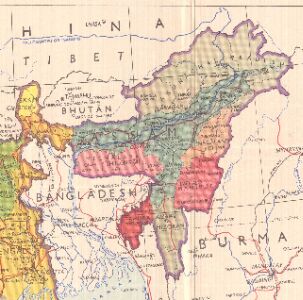A reformulated demand
Imposition of Assamese language throughout the region proved to be the trigger point for a transition from the longstanding demand for an effective Autonomous District Council to that of a statehood

A major change in the Northeast region came with the enactment of the Northeastern Areas (Reorganisation) Act, 1971, which provided for the establishment of the states of Manipur and Tripura, besides the formation of the state of Meghalaya and the Union territories of Mizoram and Arunachal Pradesh, through reorganisation of the existing state of Assam. Thus, Meghalaya became a state along with Manipur and Tripura in 1972.
However, the major difference lay in the fact that both Manipur and Tripura made the transition from being princely states to Chief Commissioner's provinces in 1949 to Union Territories in 1963, and finally to full-fledged states in 1972, while for Meghalaya, it was the fulfilment of a longstanding demand, first of an effective Autonomous District Council within Assam, and then of statehood after there were attempts to impose Assamese throughout the region. The story of Meghalaya is also intertwined with the lost glory of Shillong, as well as the shrinking territorial contours of Assam.
The creation of Meghalaya is best expressed by Swarna Rajagopalan in her report 'Peace accords in Northeast India': "The formation of Meghalaya began as a demand for a stable hill state in the Northeast, but was replaced by demands from several groups for their own states, and the All-Party Hill Leaders Conference (APHLC) focused its attention on the Khasi-Jaintia and Garo Hills, which already had autonomous councils provided by the sixth schedule. A proposal to create a Hill Areas Committee in the Assam state assembly quickly yielded to the demand by the residents of Khasi-Jaintia and Garo Hills for statehood of Meghalaya when the Assamese language was adopted state-wide as a medium of instruction". It must be mentioned that in the early 1950s, most legislators from the hill districts were pressing for greater autonomy of the councils under the Sixth Schedule, and elected chairmen for all district councils besides representation of the councils in the cabinet. They also wanted a limitation on the 'veto powers' of the Governor, and last but not the least, the control of Shillong Municipality by the Khasi Hills Council. In fact, the wish to control Shillong was at the root of the contest between the state of Assam, and the protagonists of the Khasi assertion.
By 1962, the APHLC became a political party, contested elections, and had outstanding success in all the autonomous districts, except Mikhir and North Cachar. However, discussions with PM Nehru were inconclusive and his successor Lal Bahadur Shastri appointed the Pataskar Commission, whose recommendations stopped short of a separate state, and were hence rejected by the APHLC. In 1967, the Centre proposed reorganisation of Assam on the basis of a federal structure — a sub-state for the hills. The sub-state would comprise two districts of Khasi & Jaintia and Garo hills, with the option to the 2,80,000 people of the UMNC districts to join in. If Mikhir and North Cachar district councils decide, they could do so by a two-thirds vote. The sub-state was to have the same administrative setup with a Chief Minister and a Chief Secretary — as any of the states, but the powers transferred to it did not include such subjects as law and order, highways, major industries, major irrigation, drainage, power and navigation projects, and control over the municipality and cantonment of Shillong — the state capital, located in the K&J district. All concurrent powers (as defined under the Indian Constitution) remained with the Assam legislature, but with respect to transferred subjects; this resulted in the loss of powers of the state on account of autonomy given to the hills. Moreover, a standing committee consisting of the 16 hill representatives in the Assam Assembly had a 'pre-emptive right' to pass laws on subjects of interest to the hill districts.
Creation of the Northeastern Council
The most interesting part of the sub-state scheme was the proposal for a Northeastern Council (NEC) to be presided over by the Governor of Assam. The Chief Ministers of Assam, Nagaland and the new autonomous state must be members, along with one other minister from each state. The Union Territories of Manipur and Tripura were to be represented by their Chief Commissioners and the Chief Ministers of the territorial councils. The NEC was to undertake integrated development planning for the whole region, and its Security Sub-Committee had the mandate to look at policies in the context of external and internal threats. This was also an answer to criticism that reorganisation may expose Assam to security risks. Only Jana Sangh — the precursor to BJP — had reservations about what this 'fragmentation' would do to the unity and security of India. However, the leadership of the armed forces was strongly in favour of a negotiated settlement with the hill people, lest the situation deteriorated into yet another insurgency.
Views expressed are personal



